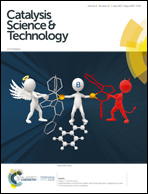Doping effect of Sm on the TiO2/CeSmOx catalyst in the NH3-SCR reaction: structure–activity relationship, reaction mechanism and SO2 tolerance†
Abstract
A series of environmentally benign TiO2/CeSmOx catalysts were prepared by combining coprecipitation and impregnation methods. The effect of doping Sm species into CeO2 for selective catalytic reduction of NO by NH3 (NH3-SCR) was investigated. The results of catalytic tests displayed that the catalyst with the optimal molar ratio (Ce : Sm = 20 : 1) exhibited the best deNOx performance. Moreover, the NH3-SCR efficiency of TiO2/CeSmOx (Ce : Sm = 20 : 1) was higher than that of TiO2/CeO2. The obtained samples were characterized by BET, XRD, Raman, HAADF-STEM, XPS, H2-TPR, NH3-TPD and in situ DRIFTS techniques to investigate the effect of Sm doping on the physiochemical properties of the TiO2/CeSmOx catalyst. The XRD, Raman and HAADF-STEM results revealed that the Sm dopant had been incorporated into the CeO2 lattice successfully, and the Ti species were highly dispersed on the CeSmOx support. The H2-TPR, NH3-TPD and in situ DRIFTS results suggested that the redox properties and surface acidity of the catalyst were adjusted to a good balance by the introduction of Sm species, which were beneficial to the enhancement of the catalytic activity at low temperatures (<300 °C). In addition, the NH3-SCR reaction followed the Langmuir–Hinshelwood mechanism on the TiO2/CeO2 catalyst surface in the whole temperature range. The introduction of Sm species changed the reaction pathway, and both the Eley–Rideal and Langmuir–Hinshelwood mechanisms existed when the temperature was higher than 250 °C. Furthermore, the addition of Sm to the TiO2/CeO2 catalyst improved the H2O and SO2 resistance ability of the catalyst due to suppression of the bulk sulfate formation.



 Please wait while we load your content...
Please wait while we load your content...